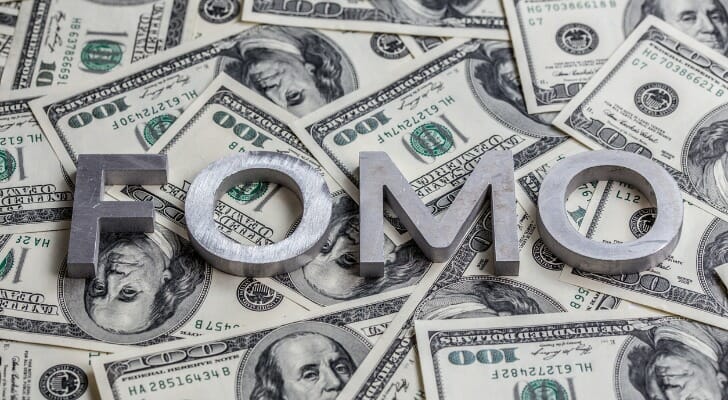 Investors have two primary emotions, fear and greed, according to CNN Money. The news service believes in this so much that it has created a metric around the idea. The Fear and Greed Index measures how investors across the entire stock market are feeling at any given point. When they’re fearful, expect selloffs and retrenched positions; when they’re greedy, expect buyers to snap up securities.
Investors have two primary emotions, fear and greed, according to CNN Money. The news service believes in this so much that it has created a metric around the idea. The Fear and Greed Index measures how investors across the entire stock market are feeling at any given point. When they’re fearful, expect selloffs and retrenched positions; when they’re greedy, expect buyers to snap up securities.
If you need help with your portfolio, consider talking to a financial advisor.
What Is the Fear and Greed Index?
The Fear and Greed index is a metric published by CNN Money that measures investor sentiments across the stock market on a scale that ranges from zero, or “Extreme Fear,” to 100, or “Extreme Greed.” As CNN describes its own system: “Investors are driven by two emotions: fear and greed. Too much fear can sink stocks well below where they should be. When investors get greedy, they can bid up stock prices way too far.”
In theory, the closer the index gets to zero, the more likely it is that investors are probably selling too heavily and undervaluing the market. As the index rises toward 100 it means that investors are probably buying too heavily and overvaluing the market. CNN publishes its Fear and Greed Index every day. It keeps a weekly, monthly and annual index as well.
How Is the Fear and Greed Index Calculated?
The Fear and Greed Index is typically scaled from 0 to 100, where lower values indicate extreme fear (potential buying opportunities), while higher values signify extreme greed (potential market overvaluation).
1. Stock Price Momentum
How does the current S&P 500 index compare to its 125-day moving average? If the index closes above this average, that indicates greed on the part of investors. Trading activity has driven prices up across the market. If the index closes below the average, this indicates that investors are fearful and driving prices down.
2. Stock Price Strength
How many stocks have hit 52-week highs and 52-week lows on the New York Stock Exchange? When more stocks hit a 52-week high than hit a low point over that same period, this indicates greed. More investors are driving stocks to peak trading prices. When more stocks hit a 52-week low than hit a high point over that same period, this indicates fear. More investors have abandoned stocks and have driven them to bottom-out trading prices.
3. Stock Price Breadth
The volume of shares traded in stocks whose prices are rising compared to the volume of shares traded in stocks whose prices are declining. This measures activity and behavior across the market. The more trading that takes place among price-positive stocks, the greedier the market is. The more trading that takes place among price-negative stocks, the more fearful.
4. Ratio of Put Options to Call Options
How many call options have traders purchased vs. how many put options have they purchased? Call options are a bullish position, indicating that the trader expects prices to go up. When more traders take this position it indicates greed on the part of the market. Put options are a bearish position, indicating that the trader expects prices to go down. When more traders take this position it indicates fear on the part of the market.
5. Demand for Junk Bonds
What is the spread between the yields of junk bonds and investment-grade bonds? When this spread is narrower it means that more investors are buying high-risk, high-reward junk bonds (allowing those borrowers, in turn, to offer reduced yields due to higher demand). This indicates greed in the market. When the spread is wider, it means that investors are taking safer positions and avoiding the risky position junk bonds offer. This indicates fear and worries over a coming bear market.
6. Market Volatility
The most widely used measure of share price volatility is the CBOE Volatility Index, or VIX, It measures the U.S. stock market’s 30-day expected or forward-looking volatility based on S&P 500 options. CNN uses it based on a 50-day moving average. Higher levels of volatility are associated with higher levels of fear, as investors abandon positions and open new ones in an uncertain market. Lower levels of volatility are associated with higher levels of greed, as investors hold onto assets they expect to increase in value.
7. Demand for Safety
What is the difference in return on stocks vs. U.S. Treasury bonds? When Treasury bonds outperform stocks, this suggests that investors expect prices to fall and are trying to get their money out of the stock market and into a safe investment. This is an indication of fear. When the stock market outperforms Treasury bonds, this suggest that traders are willing to pull their money out of the safety of Treasurys and assume the risks of investment. This is an indication of greed.
Reading the Fear and Greed Index

The best way to approach the Fear and Greed index is to consider it an indicator of when the market is overvalued and undervalued. During periods of high fear, investors are pulling their money out of the stock market. They are selling assets at a higher-than-normal rate for lower-than-normal prices. This is a good indicator that the market has become undervalued.
As an investor, periods of high fear are likely a good time to buy into the market. Prices are low and likely poised to rise. It is a bad time to exit a position for the same reason. During periods of high greed investors have entered the stock market in larger numbers. They are buying assets at a higher-than-normal rate for higher-than-normal prices or are holding assets at a higher-than-normal rate while waiting for prices to rise.
This makes periods of high greed a bad time to buy into the market. However, if you are looking to exit the market, the elevated prices of a high-greed market make for a good opportunity.
Bottom Line

The Fear and Greed Index is a measure of market sentiment published by CNN Money. As this metric focuses on share prices and trading volume it can be thought of as a type of technical analysis rather than a type of fundamental analysis, which assesses the financial performance of a company or industry. When greed is high, expect prices to rise and assets to potentially become overvalued. When fear is high, expect prices to fall and assets to potentially become undervalued.
Investing Tips
- A financial advisor can help you keep emotions, such as fear and greed, from running your investing. Finding a financial advisor doesn’t have to be hard. SmartAsset’s free tool matches you with vetted financial advisors who serve your area, and you can have a free introductory call with your advisor matches to decide which one you feel is right for you. If you’re ready to find an advisor who can help you achieve your financial goals, get started now.
- During the coronavirus crisis investing has become unusually risky, with prices falling before they rise before they fall before they rise again in a world-historically volatile market. However, there several investing guides you can follow that are especially helpful during the pandemic.
Photo credit: ©iStock.com/PeopleImages, ©iStock.com/z1b, ©iStock.com/tang90246